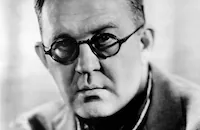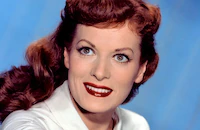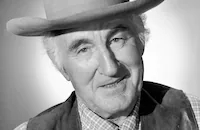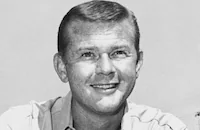The Long Gray Line

Brief Synopsis
Cast & Crew
John Ford
Tyrone Power
Maureen O'hara
Robert Francis
Donald Crisp
Ward Bond
Film Details
Technical Specs

Synopsis
In a specially arranged meeting with President Dwight D. Eisenhower, Army officer Martin Maher complains that the United States Military Academy at West Point, where he has served for fifty years, is forcing him into retirement. Protesting that he is perfectly healthy, Marty remembers his first day at the Academy: Having just arrived from County Tipperary, Ireland, Marty reports to West Point to begin his job as a waiter. Unimpressed with military discipline, and too much the exuberant Irishman to maintain a silent and respectful demeanor, Marty gets himself into trouble from the very beginning. His salary proves insufficient to pay for the dishes he constantly breaks, and when he realizes that enlisted men receive better treatment than do hired laborers, he immediately joins up. Mistakenly believing that Corp. Rudolph Heinz betrayed a cadet, Marty fights the officer, and is placed in the guardhouse. Upon his release, he learns that Capt. Herman J. Koehler was impressed with his boxing skills and wants him to assist in athletics instruction. Soon after Marty begins teaching boxing classes, he meets Mrs. Koehler's cook, Mary O'Donnell, an attractive young woman who has just arrived from County Donegal. It is love at first sight for Marty, but Mary refuses to speak to him. Exasperated, Marty finally proposes and is astonished when Mary says yes. Capt. Koehler, she explains, had advised her to remain silent because to speak to an argumentative Irishman would have invited an immediate fight. The two do fight but are married nonetheless. Over the following few years, Marty becomes a corporal, and Mary saves enough money to bring his father and brother Dinny to America. Dinny becomes a successful businessman, and although Mary loves West Point, Marty decides to quit the military and join his brother's firm. When Mary becomes pregnant, however, he re-enlists. The baby, named Martin Maher, III, dies only hours after his birth, and Mary learns that she may never have another child. The cadets, who cherish the couple's friendship, remain with them during their grief. One of these cadets is James "Red" Sundstrom, who worries that he will be dismissed because of his poor grades. Marty and Mary introduce him to Kitty Carter, who tutors Red and, after several years, becomes his bride. As time passes, Marty continues to earn the love and respect of cadets such as Omar Bradley, James Van Fleet, George Patton and Eisenhower. When the U.S. enters the war in 1917, both Marty and his father try to join the troops at the front, but Koehler, now a colonel, argues that they are needed at the Academy. Soon after the armistice is signed, Marty hears that Red has been killed, and in pain and disgust, he again decides to leave the Academy. Kitty receives Red's posthumously awarded medal of honor, along with an honorary West Point appointment for her baby son. When she reacts with bitterness, it is Marty who reminds her how important military service was to Red. Years later, Marty is still at West Point, and James "Red" Sundstrom, Jr., along with the sons of others whom Marty had trained, is becoming a cadet. News of Japan's attack on Pearl Harbor is announced, whereupon Red, Jr. makes a confession to Marty: He has broken the Academy's code of honor by secretly marrying and then having the marriage annulled. Because Red, Jr. is like a son to her, Mary begs Marty to keep quiet about the incident, but the breach of honor so disturbs him that he decides to retire. During their conversation, Red, Jr. and Kitty arrive. Red, Jr. has resigned from the Academy, enlisted in the Army, and is being shipped overseas. Beaming with pride, Marty watches him depart. Later, Mary attempts to view one of the parades she so loves, but her health is too poor and she is forced to watch the proceedings from her own porch. As Marty is fetching her shawl, she quietly dies. On Christmas Eve, Marty returns home alone. He begins to prepare a poor supper for himself but is interrupted by a group of lively cadets. Suddenly Kitty arrives with Red, Jr., who has earned his captain's bars on the battlefield and wants Marty to pin them on. By Eisenhower's desk, Marty completes his reminiscences, adding that West Point "has been my whole life." Eisenhower contacts West Point, and when Marty returns to the Academy, the cadets arrange for a full dress parade in his honor. As the band plays a series of Irish tunes, all the people Marty loves, both living and dead, join the marching cadets on the field.

Director

John Ford
Cast

Tyrone Power

Maureen O'hara

Robert Francis

Donald Crisp

Ward Bond

Betsy Palmer

Phil Carey

William Leslie

Harry Carey Jr.
Patrick Wayne
Sean Mcclory

Peter Graves

Milburn Stone
Erin O'brien Moore
Walter D. Ehlers

Willis Bouchey
Don Barclay

Martin Milner
Chuck Courtney
Maj. Philip J. Kieffer
Norman Van Brocklin
Elbert Steele
Diane Delaire
Donald Murphy
Lisa Davis
Dona Cole
Pat O'malley
Harry Denny
Robert Knapp
Denny Niles
Gene Whittington
Mark Andrews
Jim Moloney
Don Oreck
Harry Mckim
Robert Roark
Robert Hoy
Robert Ellis
Mickey Roth
Tom Hennessy
John Herrin
James Lilburn
Jack Pennick
Peter Ortiz
William Boyett
Mimi Doyle
James Sears
Mickey Simpson

Ken Curtis
Norma La Roche
Pat Harding
Jean Moorhead
Dorothy Ann Seese
Mary Benoit
Fritz Apking
Chester Jones
Hubert Kerns
David Armstrong
Erwin Neal

Jack Mower
Jack Del Rio
Raoul Freeman
Jack Ellis
Barry Regan
Joe Brooks
Guy Way
Leon C. Mclaughlin
Crew
Robert Arthur
Clay Campbell
George Cooper
Jack Corrick
Francis Cugat
George Duning
Edward Hope
Helen Hunt
Charles Lawton Jr.
John Livadary
Jean Louis
William A. Lyon
Lt. Col. George Mcintyre
Richard Olson
Maj. George Pappas
Robert Peterson
Ernie Reichert
Wingate Smith
Morris Stoloff
Frank [a.] Tuttle

Photo Collections
Videos
Movie Clip




Hosted Intro
Film Details
Technical Specs

Articles
The Long Gray Line
There are times, following Marty's marriage to Maureen O'Hara's Irish compatriot, Mary O'Donnell, and the arrival of his father from the Auld Sod to take up residence with them at the Academy, when The Long Gray Line makes The Quiet Man, Ford's 1952 Irish excursion, seem like Lars von Trier's Breaking the Waves (1996). On the other hand, certain moments of familial closeness remind you that Ford had directed How Green Was My Valley (1941). The sentiment comes across as the real thing, and so does the patriotism in the loyal hearts of the Mahers, who included Donald Crisp as the elder Maher, modeled, it is said, on Ford's own father (and echoing Crisp's How Green Was My Valley patriarch). O'Hara had of course starred opposite Ford regular John Wayne in The Quiet Man. Casting her in this role was a natural. She has never been more vibrant. Nor was it her first brush with West Point in the movies. In Henry Hathaway's Ten Gentlemen from West Point (1942), she played an early 19th century Washington socialite who was instrumental in the founding of the USMA.
Ford not surprisingly wanted Wayne as Marty. But Wayne's protracted presence on another movie led Ford to cast Tyrone Power, his real-life neighbor (and ex-Marine). Power seems relieved and refreshed at being sprung from the swashbucklers that gave him most of his employment, especially as Maher mellows with the years. The passage of time, haunted by the wartime deaths of so many officers, enables Ford to sidestep the trap of allowing the film to veer into empty flag-waving. As with many American adults of the period, Ford's WW II experience (in the U.S. Navy) as a maker of documentaries darkened his view of life and the world. While Marty's view of the young officers as extended family is believable, so is his melancholy at seeing so many of them sent off to die. There's more darkness in this patriotic film than you might suppose.
Drawn from Maher's memoir, it's framed as a long flashback that begins in the Oval Office with an aging Maher asking President Eisenhower to intervene and keep Maher from being retired. We see Ike (Elbert Steele) only from the rear, ironically, in a scene that seems a steal from the opening of Yankee Doodle Dandy (1942), when Jimmy Cagney's George M. Cohan is summoned to a meeting with FDR, also seen in a rear view, and heard, but never frontally. The difference here is that Maher knew young Ike (and Omar Bradley, George Patton and Douglas MacArthur) as cadets, and addresses them with appropriate respect, but also with familiarity. (Harry Carey, Jr., a Ford stock company regular, plays young Ike; mainstay Bond plays Maher's gruff West Point mentor; John Wayne's son, Patrick, plays another cadet and, in a cameo, then Los Angeles Rams star Norm Van Brocklin plays a Notre Dame quarterback.)
In fact, the male-oriented West Point society resonated with the male-dominated microcosm on Ford's shoots. He took to Betsy Palmer, a stage-trained actor (like Power) making her Hollywood film debut as a spirited, open-eyed modern woman who eventually buys into patriotism, but not before questioning it after her husband dies in combat and her grown son goes off to war. Ford reserved his trademark caustic treatment for O'Hara, who angrily recalled it years later in her autobiography. But if it was his way of getting her Irish blood up, it worked splendidly, and didn't impede O'Hara's decision to avoid the maudlin in Mary's death scene by simply having her die quietly, even discreetly, as we see her seated on a porch from the rear, and her hand simply goes limp.
It's one of the film's few discreet renderings of sentiment, which reaches a crescendo near the end when Marty is being honored by rank after rank of cadets passing in review and the usual Sousa marches are replaced by a medley of traditional Irish tunes as Marty sees visions of his late wife and father on the parade ground. Still, even here, The Long Gray Line represents a triumph of conviction over stereotyping and shows few signs of Ford's complaints that he felt handicapped by having to film in CinemaScope, with the wider frame ratio distending and diluting his compositional approach. He can't have hated CinemaScope all that much. As an add-on, he filmed a 10-minute short with the cast selling U.S. Savings Bonds. He called it "The Red, White, and Blue Line." It, and the main event, are very much of their time and not much of ours. But while it's never going to turn up on John Ford greatest hits lists, it's nevertheless a mission accomplished.
Producer: Robert Arthur
Director: John Ford
Screenplay: Edward Hope, Nardi Reeder Campion (book), Marty Maher (book)
Cinematography: Charles Lawton, Jr.
Film Editing: William A. Lyon
Art Direction: Robert Peterson
Music: George Duning, Morris Stoloff
Cast: Tyrone Power (Martin Maher), Maureen O'Hara (Mary O'Donnell), Robert Francis (James Sundstrom, Jr.), Donald Crisp (Old Martin), Ward Bond (Capt. Herman Kohler), Betsy Palmer (Kitty Carter).
C-138m.
by Jay Carr

The Long Gray Line
Sean McClory (1924-2003)
Born on March 8, 1924 in Dublin, Ireland, he became a leading man at the famous Abbey Theatre in the early '40s and relocated to the United States shortly after World War II. His first roles were small bits as a police officer in two RKO quickies: Dick Tracy's Dilemma and Dick Tracy Meets Gruesome (both 1947). He eventually graduated to more prestigious pictures like The Glass Menagerie (1950), Les Miserables (1952) and John Ford's The Quiet Man (1952).
After a few more supporting roles in quality pictures: Niagara (1953); the sci-fi chiller Them! (1954); and for John Ford again in The Long Gay Line (1955), McClory turned to television. He kept busy for several years with guest roles in a variety of popular shows: Bonanza, Wagon Train, Rawhide, Gunsmoke, The Outer Limits (1964) and countless others. By the mid-'60s, McClory became slightly more heavy-set, and began tossing off variations of jovial, "oirish" blarney for, yet again John Ford in Cheyenne Autumn (1964); and in a string of Disney pictures: Follow Me, Boys! (1966, his best role, a moving performance as the alcoholic father whose behavior alienates his son, played by a 15-year old Kurt Russell); The Happiest Millionaire (1967), and The Gnome-Mobile (1967), before he returned to television. His final role was in John Huston's acclaimed Irish opus The Dead (1987). He is survived by his wife, Peggy Webber McClory.
by Michael T. Toole
Sean McClory (1924-2003)
Quotes
Trivia
Notes
The working title of this film was Mister West Point. The film begins with the following written foreword: "The United States Military Academy at West Point is 153 years old. This is the true story of an enlisted man who was there for 50 of those years. His name is Marty Maher." The phrase "the long gray line" refers to the succession of officers who have been educated at the United States Military Academy at West Point, NY, many of them sons and grandsons of earlier graduates. It also refers to the line of cadets, who wear grey uniforms. In May 1947, Los Angeles Times reported that Robert Fellows was planning to produce a film set at West Point entitled The Long Gray Line for Paramount, but it has not been determined if that project is related to this film.
According to New York Times, producer Jerry Wald had originally wanted to produce a film adaptation of Maher's life story while under contract to RKO. The studio, however, refused to purchase the rights, and after his production company, Wald-Krasna, was dissolved, Wald took an executive producer position at Columbia. He then convinced that studio to purchase the book and assigned Robert Arthur to produce. After casting problems delayed the production, Arthur left Columbia for Universal-International. Later, when Tyrone Power was hired to star and John Ford to direct, Arthur was borrowed back from Universal-International to produce the film. Hollywood Reporter casting information adds Stewart Vannerson, Richard Bishop and Allen Norse to the film, but their appearance in the final film has not been confirmed. According to Motion Picture Herald Prod Digest and Hollywood Reporter, portions of the film were shot at West Point. The film was the first CinemaScope picture to be directed by Ford and was his first film after a nearly one-year layoff due to eye surgery. The Long Gray Line was the last film of actor Robert Francis (1930-1955), who died on July 31, 1955 in a plane crash.

Miscellaneous Notes
Released in United States Fall September 1955
Released in United States January 28, 1990
Shown at American Museum of Moving Images, New York City January 28, 1990.
CinemaScope
Released in United States January 28, 1990 (Shown at American Museum of Moving Images, New York City January 28, 1990.)
Released in United States Fall September 1955














